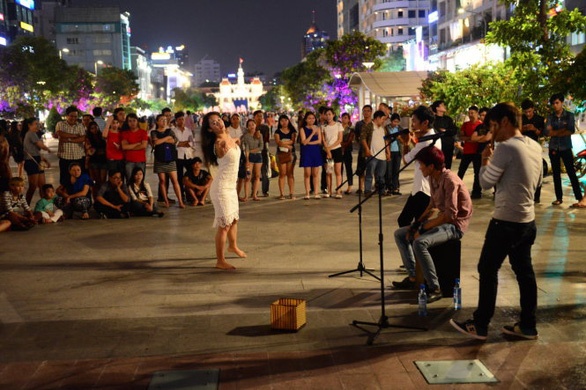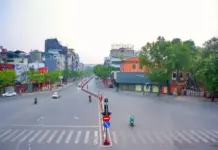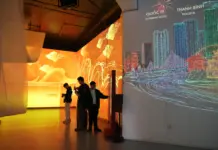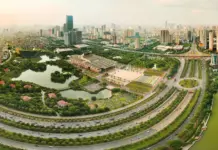The story is written by Lee Andre Chan from Canada, in response to the ‘Ho Chi Minh City Goes Global’ contest, an open forum for readers to contribute their ideas and solutions to raise the position of Saigon – Ho Chi Minh City in the international arena.
The contest is co-organized by Tuoi Tre (Youth) newspaper and the Ho Chi Minh City Department of External Relations to prepare for the celebration of Vietnam’s National Day on September 2.
It was titled and edited by Tuoi Tre News for clarity, consistency, and coherence.
Create a livable city
From the perspective of a tourist and business traveler who has visited it numerous times, I marveled how Ho Chi Minh City has flourished economically. However, with economic growth and urban sprawl come environmental issues such as traffic congestion and air pollution/noise, seasonal flooding caused by impermeable concrete, solid waste including plastic waste and the Urban Heat Island Effect. The latest Intergovernmental Panel on Climate Change (IPCC) report highlights the urgency to address climate change.
A livable Ho Chi Minh City would meet several of the United Nations Sustainable Development Goals by embracing a circular economy that reduces waste and improves the urban environment and socio-economic prosperity.
Ho Chi Minh City should aim to accentuate its unique character while improving its environment for both residents and visitors.
Traffic
Congestion and air pollution from the millions of motorbikes and thousands of vehicles are the first visitor experiences upon arrival in Ho Chi Minh City.
Establishing more major commuter routes between districts using high-frequency and modern bus rapid transit systems (BRTS) will divert high volumes of commuter traffic from the roads.
BRTS stopovers can be developed into business, cultural, and shopping hubs that reflect the distinct character of each district giving people the incentive to use this alternative transportation due to convenient access to attractive shopping and business venues.
Establish weekends where major streets are pedestrian-only with live entertainment, outdoor ‘pop-up’ cafés, mini-shops, and impromptu markets. The promenade along Nguyen Hue Street should be copied on other main streets.
For short inner-city trips, establish solar-powered recharging stations at many key locations within each district for electric-powered scooters and cars, thus preserving the motorbike ‘culture’ of the city while replacing the dirty gas motors with cleaner renewable energy units. Offer financial incentives for residents to invest in electric transportation.
Flooding, garbage, and greening
Every May heralds annual flooding with more frequency and severity which impacts livability and businesses. Clearing refuse from canals leading into the Saigon River allows more free-flow and alleviates back-up of storm water onto streets.
Shoreline rehabilitation along these canals such as relocation of any slum areas, natural stabilization against erosion through native plants which beautify the waterways, and maintenance dredging to deepen the canals would clean and enhance water flow and improve esthetics. The rehabilitation of Nhieu Loc – Thi Nghe Canal can be replicated to other canals and all can be focal attraction points, similar to those in the Netherlands, for tourism and business.
Anyone would love a cà phê sữa đá (Vietnamese iced milk coffee) next to a clean river in a parkette/restaurant decorated with orchids and palm trees while electric motorbikes/cars quietly pass by.
Vast amounts of street litter that washes into the canals flow into the East Sea via flooding/rainstorms. As Vietnam is a significant contributor to marine plastic pollution, continuously implementing widespread awareness programs for residents to recycle glass, metal, and plastics is important.
Encourage participation in a rewards program, which can also include informal waste collectors (most of whom are women) leading to entrepreneurial opportunities. This would alleviate litter accumulation and overfilling landfills.
A successful circular economy program can be showcased to demonstrate globally Ho Chi Minh City’s commitment to clean oceans, job creation for the poor, and resource conservation opportunities.
Green infrastructure is becoming popular globally in major cities. Green roofs and walls, urban parks, and community vegetable gardens in vacant properties (which promote food security for marginalized peoples) reduce urban heat temperatures, dampen noise pollution, improve air quality, attract butterflies/birds, beautify the city’s esthetics, and divert storm water from the streets and canals by absorbing and storing water thus alleviating flooding. The stored water can then be used for urban vegetable/fruit gardens during drought. Reducing municipal water demand also lowers energy costs and promotes water sustainability.
Green infrastructure reduces the Urban Heat Island Effect where the city is much hotter than the countryside. As a visitor I notice the great temperature difference between Ho Chi Minh City and the cooler Mekong Delta.
Green infrastructure can significantly reduce the climate change-induced impacts on the city from extremes in weather patterns – from either too much rain or from being too hot and dry.
Within the C40 Cities global network, major cities signed a pledge to establish more green spaces and be more sustainable. During the current pandemic, citizens of these various cities requested more green space for physical exercise and happiness — characteristics of a livable city.
Greening initiatives would achieve environmental and social well-being goals by the integration of economical circularity and sustainability and therefore address the environmental and socio-economic issues associated with urban sprawl.
By becoming climate-resilient, Ho Chi Minh City can show the world that it is meeting several of the United Nations Sustainable Development Goals: Zero Hunger, Good Health and Well-Being, Reduced Inequalities, Sustainable Cities and Communities, Life Below Water, Life on Land, Industry/Innovation and Infrastructure.
Internet of Things (IoT)
Ho Chi Minh City should be more innovative in applying IoT as a tool in improving livability and to progress in global 5G implementation by employing many applications including:
– Optimizing the flow of traffic during peak times by controlling traffic lights at major intersections would reduce congestion and pollution from idling motorbikes and vehicles.
– Implement a waste collection system where residents, businesses, and informal waste collectors participate in a digital reward system for depositing set amounts of recyclables/refuse in collection depots located conveniently throughout the city. Reward incentives based on digital accumulation of collection points will maintain litter-free streets and canals, through discounted shopping, free data usage, free transit fares, etc.
– Develop a Ho Chi Minh City-specific app for visitors that would allow them to explore the different districts for entertainment, shopping, dining, and conventions. All useful information can be available on a smartphone that can be downloaded even before arrival. It is advisable to roll out an app on a global scale as part of a marketing plan focusing on tourists and business travelers and this app can be used to highlight successful sustainability and climate initiatives being achieved in Ho Chi Minh City.
All these initiatives would help elevate Ho Chi Minh City in the global scene.
Like us on Facebook or follow us on Twitter to get the latest news about Vietnam!




